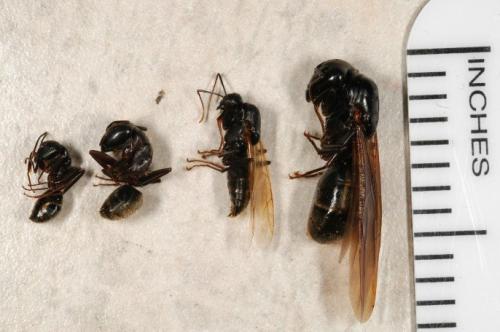Carpenter ants nesting in trees and homes
Carpenter ants in trees and houses are an indicator of a moisture and decay problem. Locating the problem gives you opportunity to act.

Are carpenter ants killing my trees?
Seeing dozens of large ants coming and going out of the base of a large tree often elicits a fear that the ants are damaging the tree. Carpenter ants do not feed on wood, but they do create galleries within rotting wood to build their nest within the tree. Unlike termites, an insect that does eat wood, carpenter ants excavate tiny bits of wood that look like course sawdust. Piles of sawdust deposited by carpenter ants can often be found at the base of the tree. The fact that you see them wandering out of the tree is the nature of ants, not termites.
Evidence of a carpenter ant nest within a tree does not indicate the tree is in a state of decline. Often, nests go unnoticed for years in healthy trees since the ants are tunneling in dead tissue and not disrupting the flow of water and nutrients.
Carpenter ants are opportunists and will look to build a nest where ever they find wood that is exposed to moisture, whether in a home, firewood or a tree with decay. Winged ants emerge in spring to early summer to seek new sites to establish their colonies.
An injury to a tree can expose wood to moisture, creating the right environment for carpenter ants to build a nest. Injury to trees can come from a lawn mower bumping into the tree, pruning wounds, a weed whip cutting through the bark, a woodpecker drilling into the tree, a buck rubbing the bark, a borer type of insect feeding under the bark or a fungal disease. Some openings through the bark are caused by the environment, including a lightning strike, broken branches due to wind and even low temperature damage to the wood of young trees. Exposure to moisture allows fungi to attack the wood and decay begins.
What are carpenter ants eating?
Carpenter ants feed on living and dead insects as a source of protein and on a sugary substance called honeydew (produced by insects like aphids and scale that siphon the sap out of plants). Carpenter ants may even forage inside a home for protein and sugar sources such as pet food, sugar, syrup and other sweets.
Are carpenter ants nesting in my home?
When you find ants searching for food within your home, it is important to first identify the ant since this will give you an indication of their nesting habits. The University of Nebraska Extension has a great Ant Identification Resources webpage.

Carpenter ants: workers, drone and queen. Photo by Duke Elsner, MSU Extension.
If the ants in your home are carpenter ants, it does not necessarily mean they are nesting in your house or building. Worker ants will forage for food up to 100 feet from their nests. They also follow common paths, so it is possible to observe the ants and follow them from your home to a nest outdoors. Sometimes, though, the nest is within the house or structure.
Nesting within a structure usually indicates wood is being damaged by water. Rotting window sills, wood located around sinks and tubs or rotting roofs are common sites where carpenter ants can be found. As with the old rotting tree, the ants are not eating the wood but excavating it.
Managing carpenter ants indoors and outdoors
Managing the problem indoors requires locating the nest and killing the ants, but also requires fixing the moisture problem and damaged wood to prevent structural problems and further ant infestations indoors.
Outdoors, carpenter ants are considered beneficial as predators of other insects. However, a nest in close proximity of a house can create a nuisance indoors as they hunt for food. Understanding the carpenter ant’s role in nature and that they are not the underlying factor in the decline of a tree are factors to consider when determining a course of action.
I see carpenter ants as an indicator of a moisture and decay problem. Knowing the problem gives you the opportunity to act. If the problem is indoors, you’ll likely need to stop a water leak to prevent further damage to a structure. If the problem is within a tree, it may mean pruning out a decaying limb where ants are nesting.
In old trees, there may be little action that can be taken when the decay is at the base of the tree other than to reduce any additional stress, especially from drought conditions. You may need to continue monitoring decay where trees are near structures to determine if there is a potential hazard of the tree collapsing. Controlling the nest itself is unnecessary to protect the health of the tree since carpenter ants are not feeding on the tree, but living within it.
For more information on managing carpenter ants, visit the University of Minnesota Extension’s Carpenter Ants webpage.



 Print
Print Email
Email




